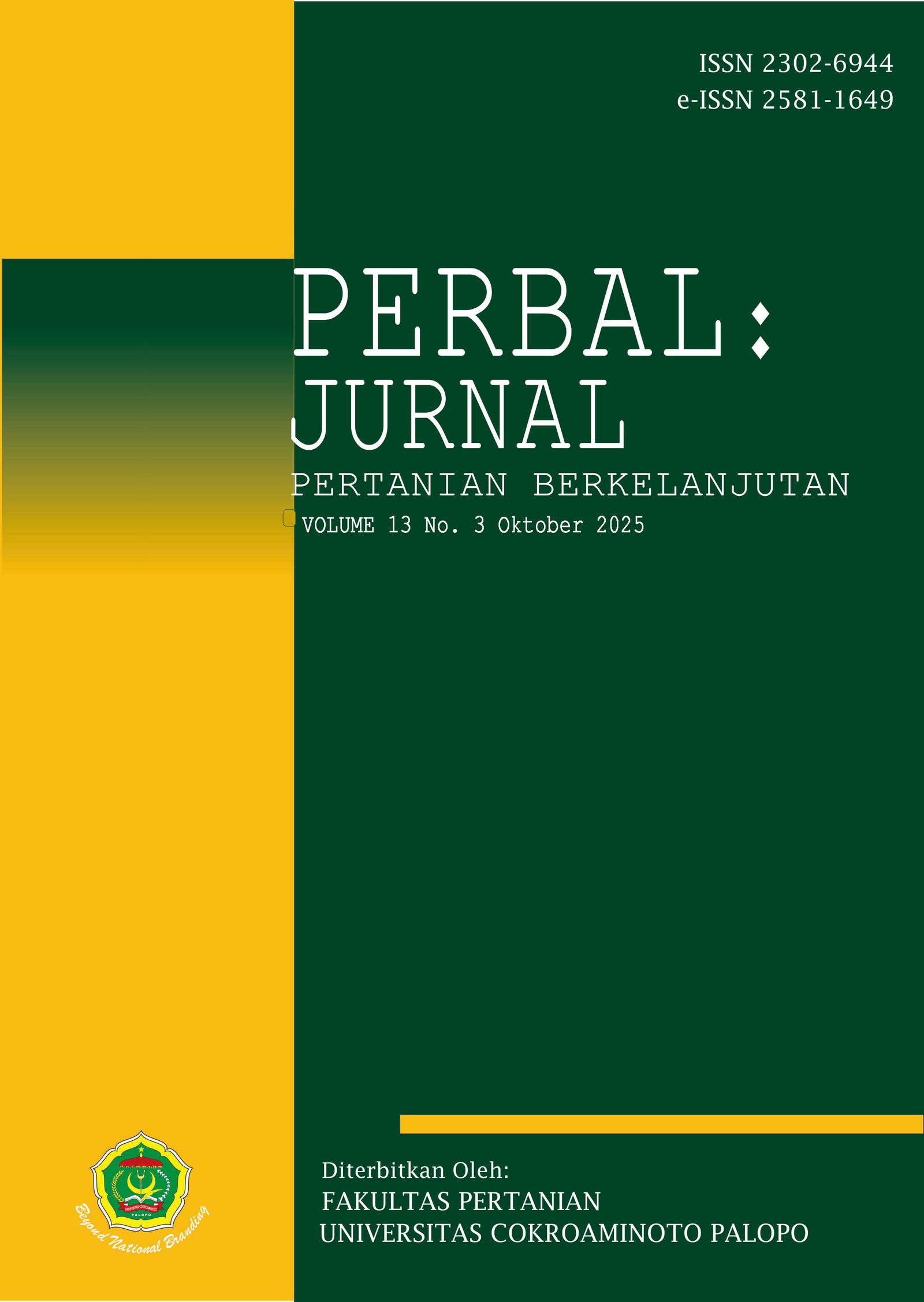Uji Invigorasi Ekstrak Bawang Merah Terhadap Viabilitas Benih Kedelai (Glycine max L.)
Invigoration Test of Shallot Extract on the Viability of Soybean (Glycine max L.) Seeds
DOI:
https://doi.org/10.30605/perbal.v13i3.6920Keywords:
Invigorasi, bawang merah, viabilitas, vigor, kedelaiAbstract
Viabilitas benih kedelai (Glycine max L.) cenderung menurun selama penyimpanan, sehingga diperlukan teknik invigorasi untuk memperbaikinya. Penelitian ini bertujuan mengkaji pengaruh ekstrak bawang merah (Allium cepa L.) terhadap viabilitas dan vigor benih kedelai. Penelitian menggunakan Rancangan Acak Lengkap Faktorial dengan konsentrasi ekstrak (0%, 20%, 40%, 60%, 80%, and 100% %) dan lama perendaman (3, 6, dan 9 jam) dengan tiga ulangan. Hasil menunjukkan bahwa konsentrasi 80% dengan perendaman 9 jam memberikan hasil terbaik, ditandai dengan potensi tumbuh sebesar 80,89%, daya kecambah 29,78% dan 19,28%, vigor 62,67%, kecepatan 15,87% dan 22,72% serta keserampakan tumbuh yang lebih tinggi sebesar 17,33%, serta penurunan kecambah abnormal sebesar 17,33% dan benih mati sebesar 22,87%.
The viability of soybean seeds (Glycine max L.) tends to decline during storage, thus requiring invigorating techniques to restore their quality. This study aimed to evaluate the effect of shallot (Allium cepa L.) extract on the viability and vigor of soybean seeds. A Factorial Completely Randomized Design was applied with extract concentrations (0%, 20%, 40%, 60%, 80%, and 100% and soaking durations (3, 6, and 9 hours), each replicated three times. The results showed that a concentration of 80% combined with 9 hours of soaking produced the best outcomes, characterized by germination potential of 80.89%, germination percentages of 29.78% and 19.28%, vigor of 62.67%, growth speed of 15.87% and 22.72%, and higher uniformity of 17.33%, along with reduced abnormal seedlings (17.33%) and dead seeds (22.87%).
Downloads
References
Adie, M. M., & Krisnawati, A. (2018). Teknologi produksi benih kedelai. Jurnal Litbang Pertanian, 37(1), 27–36.
Benard, R., Odindo, A. O., & Modi, A. T. (2021). Seed priming with plant growth regulators influences germination and seedling vigour of sweet corn (Zea mays L. var. saccharata). South African Journal of Plant and Soil, 38(1), 25–34. https://doi.org/10.1080/02571862.2020.1720347.
Bewley, J. D., Bradford, K. J., Hilhorst, H. W. M., & Nonogaki, H. (2013). Seeds: Physiology of development, germination and dormancy (3rd ed.). Springer. https://doi.org/10.1007/978-1-4614-4693-4. DOI: https://doi.org/10.1007/978-1-4614-4693-4
Farida, R., Suryanto, A., & Purnomo, D. (2020). Peningkatan keseragaman perkecambahan benih kopi melalui aplikasi zat pengatur tumbuh alami. Jurnal Produksi Tanaman, 8(9), 1015–1021.
Farooq, M., Hussain, M., & Siddique, K. H. M. (2019). Seed priming improves crop performance under suboptimal germination environments. Advances in Agronomy, 153, 169–228.
Fitriani, D., Wardati, & Nurdiana, A. (2020). Seed invigoration using natural plant growth regulators to improve seed quality of rice (Oryza sativa L.). Jurnal Agronomi Indonesia, 48(1), 69–76.
Hampton, J. G., & TeKrony, D. M. (2013). Handbook of vigour test methods (4th ed.). The International Seed Testing Association.
ISTA. (2020). International rules for seed testing 2020. International Seed Testing Association.
Kurniati, T., Gofar, N., & Nursyamsi, D. (2017). Kandungan hormon auksin pada ekstrak bawang merah dan aplikasinya terhadap pertumbuhan tanaman. Jurnal Penelitian Pertanian Terapan, 17(3), 173–179.
Lubis, R. R., Kurniawan, T., & Zuyasna. (2018). Invigorasi benih tomat kadaluarsa dengan ekstrak bawang merah pada berbagai konsentrasi dan lama perendaman. Jurnal Ilmiah Mahasiswa Pertanian, 3(4), 175–184. DOI: https://doi.org/10.17969/jimfp.v3i4.9392
Marfirani, & Melisa. (2014). Pengaruh pemberian berbagai konsentrasi filtrat umbi bawang merah terhadap pertumbuhan stek melati “Rato Ebu”. Lentera Biologi, 3(1), 73–76.
McDonald, M. B. (2015). Seed deterioration: Physiology, repair and assessment. Seed Science and Technology, 43(3), 531–541. https://doi.org/10.15258/sst.2015.43.3.12. DOI: https://doi.org/10.15258/sst.2015.43.3.12
Nugrahaeni, N. (2016). Varietas dan teknologi produksi benih kedelai. Buletin Palawija, 14(1), 45–54.
Nonogaki, H., Bassel, G. W., & Bewley, J. D. (2018). Germination—Still a mystery. Plant Science, 179(6), 574–581. https://doi.org/10.1016/j.plantsci.2010.02.010. DOI: https://doi.org/10.1016/j.plantsci.2010.02.010
Purnawati, S., Ilyas, S., & Sundarsono. (2014). Perlakuan invigorasi untuk meningkatkan mutu fisiologis dan kesehatan benih padi hibrida Intan-2 selama penyimpanan. Jurnal Agronomi Indonesia, 42(3), 180–186.
Putri, A. P., Suryanto, A., & Koesriharti, K. (2020). Seed invigoration on green bean (Vigna radiata L.) using plant growth regulators. Jurnal Produksi Tanaman, 8(6), 627–633.
Siregar, A. P., Zuhry, E., & Sampoerno, S. (2015). Pertumbuhan bibit gaharu (Aquilaria malaccensis) dengan pemberian zat pengatur tumbuh asal bawang merah. JOM Faperta, 2(1), 1–10.
Taiz, L., Zeiger, E., Møller, I. M., & Murphy, A. (2018). Plant physiology and development (6th ed.). Sinauer Associates.
Upreti, K. K., & Sharma, M. (2016). Role of plant growth regulators in abiotic stress tolerance. In N. S. Rao, A. K. Shivashankara, & R. H. Laxman (Eds.), Abiotic stress physiology of horticultural crops (pp. 19–46). Springer. DOI: https://doi.org/10.1007/978-81-322-2725-0_2
Yusuf, M., Arsyad, M., & Satria, B. (2021). Effect of gibberellin and auxin application on seed germination and seedling growth of maize (Zea mays L.). IOP Conference Series: Earth and Environmental Science, 681(1), 012025.
Downloads
Published
Issue
Section
License
Copyright (c) 2025 Tuti Handayani Arifin, Sri Soenarsih DAS, Shubzan Andi Mahmud

This work is licensed under a Creative Commons Attribution 4.0 International License.
In submitting the manuscript to the journal, the authors certify that:
- They are authorized by their co-authors to enter into these arrangements.
- The work described has not been formally published before, except in the form of an abstract or as part of a published lecture, review, thesis, or overlay journal.
- That it is not under consideration for publication elsewhere,
- That its publication has been approved by all the author(s) and by the responsible authorities – tacitly or explicitly – of the institutes where the work has been carried out.
- They secure the right to reproduce any material that has already been published or copyrighted elsewhere.
- They agree to the following license and copyright agreement.
License and Copyright Agreement
Authors who publish with Onoma Journal: Education, Languages??, and Literature agree to the following terms:
- Authors retain copyright and grant the journal right of first publication with the work simultaneously licensed under Creative Commons Attribution License (CC BY 4.0) that allows others to share the work with an acknowledgment of the work's authorship and initial publication in this journal.
- Authors are able to enter into separate, additional contractual arrangements for the non-exclusive distribution of the journal's published version of the work (e.g., post it to an institutional repository or publish it in a book), with an acknowledgment of its initial publication in this journal.
- Authors are permitted and encouraged to post their work online (e.g., in institutional repositories or on their website) prior to and during the submission process, as it can lead to productive exchanges, as well as earlier and greater citation of published work.














